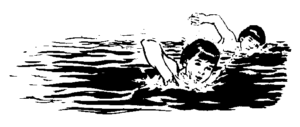Loughborough’s Other Swimming Baths
29 May 2020
In 1849 a damning report by William Lee, a senior Inspector for the Board of Health, flagged up the appalling living conditions and prevalence of disease in parts of Loughborough.
The Report was initially poorly received and it took many years before conditions improved.
By the 1880’s there was a growing interest in the link between decent working and living conditions and general health. Illness was thought to be spread by ‘miasma’ or bad smells. Clean water and proper sewage disposal were deemed necessary for all, not just the wealthy. Exercise and personal hygiene was also thought to be beneficial.
In August 1898 the magnificent Queens Memorial Baths in what was then Island House Park, now Queens Park, were opened to great public acclaim. The Baths were the personal gift of former Loughborough Mayor Joseph Griggs. Griggs engaged architects Barrowcliffe & Allcock and builders T Barker & Sons. Messrs Messenger & Co were responsible for the heating and water. The bricks were from Tuckers Brickworks.
The baths were substantial and contained not only a large swimming pool for exercise but also a laundry and private slipper baths. These all had hot and cold water and towels were provided by an attendant. At a time when only the very wealthy had indoor, fully-plumbed bathrooms, these facilities must have seemed the epitome of luxury to the average person.
However, before these baths opened there was in fact another swimming pool in Loughborough. It was on Little Moor Lane, on the canal bank, and was opened in June 1886. There is no record of who built them or paid for them but the Loughborough Herald of 3rd June 1886 reports that the land belonged to ‘the Local Board’. It was hoped the new baths would deter men and boys swimming in the canal and causing a nuisance and hazard to the many barges and boats using it.
The building was substantial: open air, 120 feet long, 40 feet wide and a varying depth from 2 – 6 feet, lined with white glazed tiles and surrounded by a corrugated fence. A corrugated dressing hut was also built. The water fed in from the canal through some sort of filter and drained out into a brook.
Initially the baths were for men only and free to use except on Wednesdays and Fridays, when it cost one penny. Eventually the facilities were improved, though they never had a roof and were open generally from May to September. Ladies were finally admitted a few years later and various other groups arranged for private use of the pool for swimming lessons. The first attendant was a Mr Mills, an ex-army PT instructor, who lived on Moor Lane.
The Borough Council Minutes continue to report on the use of both the swimming baths in the town for many years and, even after the opening of the Memorial Baths, Moor Lane continued to be well used until the turn of the century. In 1890 the Borough of Loughborough produced byelaws ‘For the Management, Use and Regulation of the Open Bathing Places in the Borough of Loughborough.’
In the same newspaper report of 3rd June 1886 there is also mention of some Public Baths, possibly small huts with a tub of sorts and a water pump in the yard, on Victoria Street, Loughborough, owned by a Mr Greaves. They are thought to have been at the back of the White Horse public house. Mr Greaves offered use of his private baths to the public if the Council would pay for the water. However, to date no further information has been found about these baths or Mr Greaves.
by Gill Pritchard, Loughborough Library Local Studies Volunteer
Read about swimming galas at the Loughborough Baths.
See photos of nine historic UK swimming pools.
Contact us at lboro.history.heritage@gmail.com if you have information on the swimming pools on Little Moor Lane or Victoria Street
